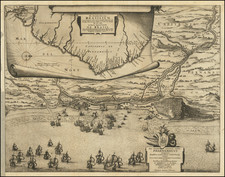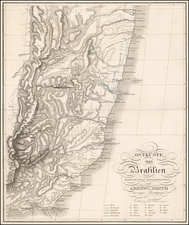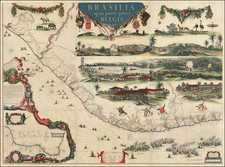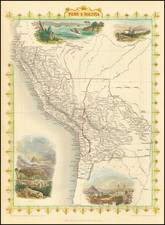The Franz Xavier Veigl / Petrus Parcar Map of The Upper Amazon Region - Ecuador - Peru
Rare Jesuit map of the Upper Amazon, including a large portion of Ecuador, Peru, northern Bolivia and the Brazilian Amazon State, published in Rome.
The map was created to illustrate the journal of Franz Xavier Veigl, an Austrian Jesuit missionary who served in the region from 1753 to 1777. The map is centered on the Upper Amazon and Ucayali Rivers and extends south to the Lima area and southeast to Exaltacion in Bolivia, illustrating the state of the missions, settlements and geographical knowledge known to the Jesuits at the time of their expulsion from the region in 1767.
Very little seems to be known about the map, although it appears that Alexander von Humboldt consulted the map during his time in Peru. (Lotz, Alexander Von Humboldt in Lima, page 285, footnote 25). The most comprehensive comment we could locate regarding the map states: "the map drawn up by Don Piedro Parcar in 1780, tracing the course of the river Marañon from its origin to the borders of the Portuguese territory and beyond." (Allgemeine Literatur-Zeitung, page 93, Volume 3, No. 183, July 1792). The map is also described by Spix and Martius in their Reise in Brasilien auf befehl Sr. Majestät Maximilian Joseph I ..., Volume 3 at page 971.
The map appeared in Reisen einiger Missionarien der Gesellschaft Jesu in America. Aus ihren eigenen Aussagen herausgegeben von Christoph Gottlieb von Murr. Mit einer Landkarte und Kupfern. published in Nuremberg in 1785. Sabin (51482) notes:
Relates chiefly to the nations on the banks of the Maranon or Amazon, and Orinoco rivers, with copious dissertations on the dialects of South America, and vocabularies of their language.
This is the second state, with a very rare first state dated 1784 and a slightly different spelling of Maragnony (Maragnonii). In addition to the change in the title, the second state of the map includes additional place names east of Lima and Guarmei, near the headwaters of the Maragnon River and just to the east, including:
- R. Consue 20 (several valleys east of Guarmei on the Coast of Peru)
- Guamico (a town just to the west of R. Consue)
- Gaurignanohe River (headwaters of the Maragnon)
- Guarcaruchuco (headwaters oof the Margnon)
- L. Chincha (northeast of Lima)
Franz Xavier Veigl (1723-1798)
Veigl was a Jesuit missionary, born in Gratz, Austria. He entered the Society of Jesus at Vienna in 1738, and for several years was professor in the Jesuit college there. He was assigned to the mission in Quito, Ecuador in 1753, finally arriving in 1755. In 1763, he was promoted to head of the missions of Mayans, a province in modern Northwest Peru, at the convergence of the Ucayali, Napo, and Amazon Rivers.
During his time in the region, he was a keen observer of the flora and fauna of the region and became one of the earliest Europeans to describe the effects of a native hallucinogenic drink, "the so-called ayahuasca, which is a bitter reed, or more specifically, a liana. It serves for mystification and bewitchment."
He remained in South America until 1777, when he returned to Europe, and was appointed professor at Judenburg.
Veigl was the author of Reisen einiger Missionitrien der Gesellschaft Jesu in Amerika" (Nuremberg, 1785) and " Franz Xav. Veigl's vormaligen Missionars der Gesellschaft Jesu, grundliche Nachrichten fiber die Verfassung der Landschaft Maynas in Sud-Amerika bis zum Jahr 1768"(1798; in Latin, 1792). No. 773 and No. 774 of Stocklein's "Welt-Bore" (Gratz, 1727 et seq.) contain his "Summa epistolarum duarum ad cognatos suos in itinere scriptarum 1753 et 1755 quibus id ipsum et quae in eo observavit describit" and "Epistola ad cosdem ex Quito 1 Septembris 1755 qua horribilem terrae in civitate hac, et statum missionum ad flumen Maragnon describit."
Rarity
The map is extremely rare.
OCLC locates 1 copy of the second state (British Library). We note also the examples at the JCB and BnF. The Catalogs of the University of Bern, Harvard Library (18321) and National Library of Brazil (1881) also reference the second edition of the map.
The only known example of the first state can be seen here: https://www.raremaps.com/gallery/detail/53837














